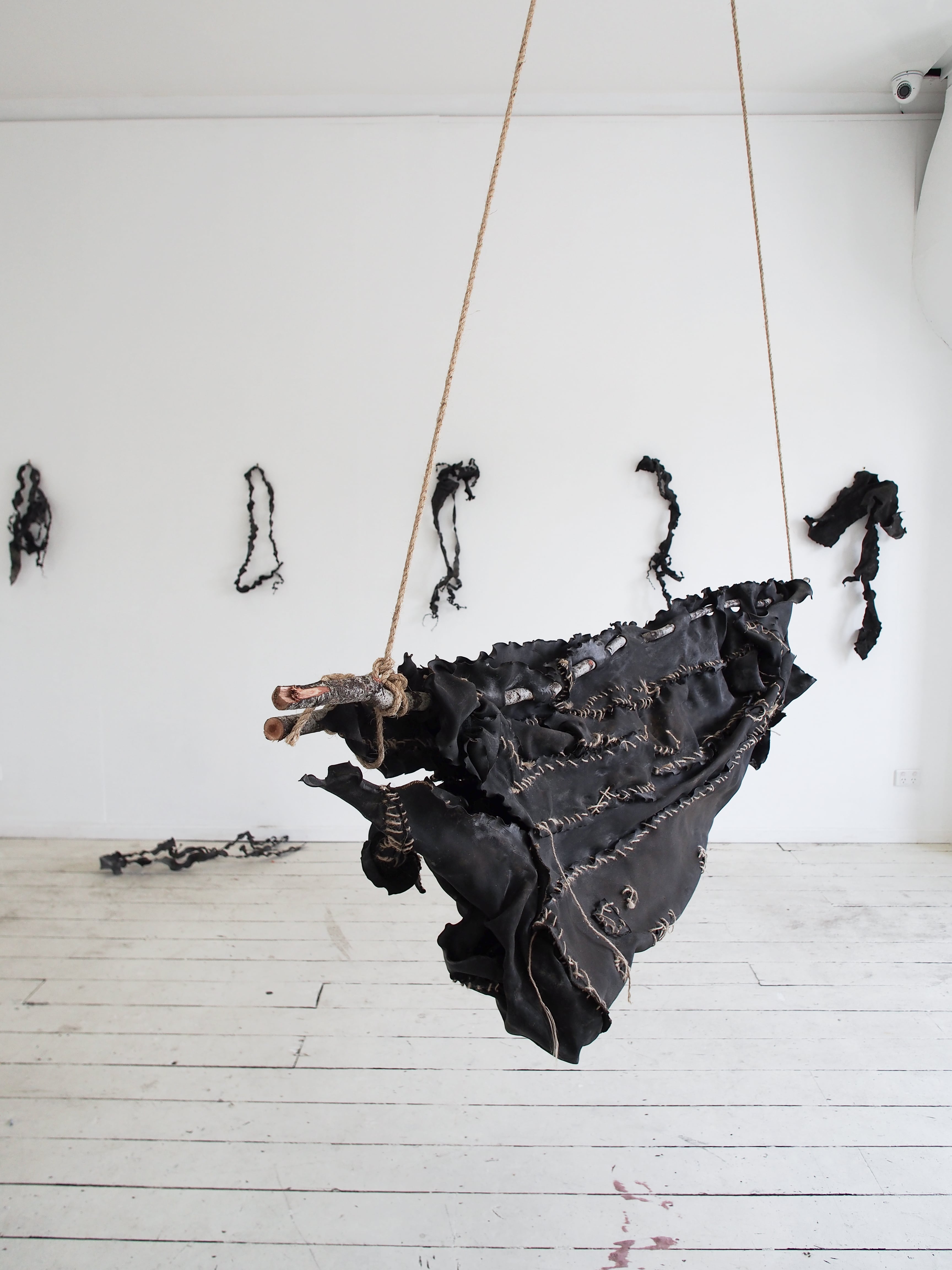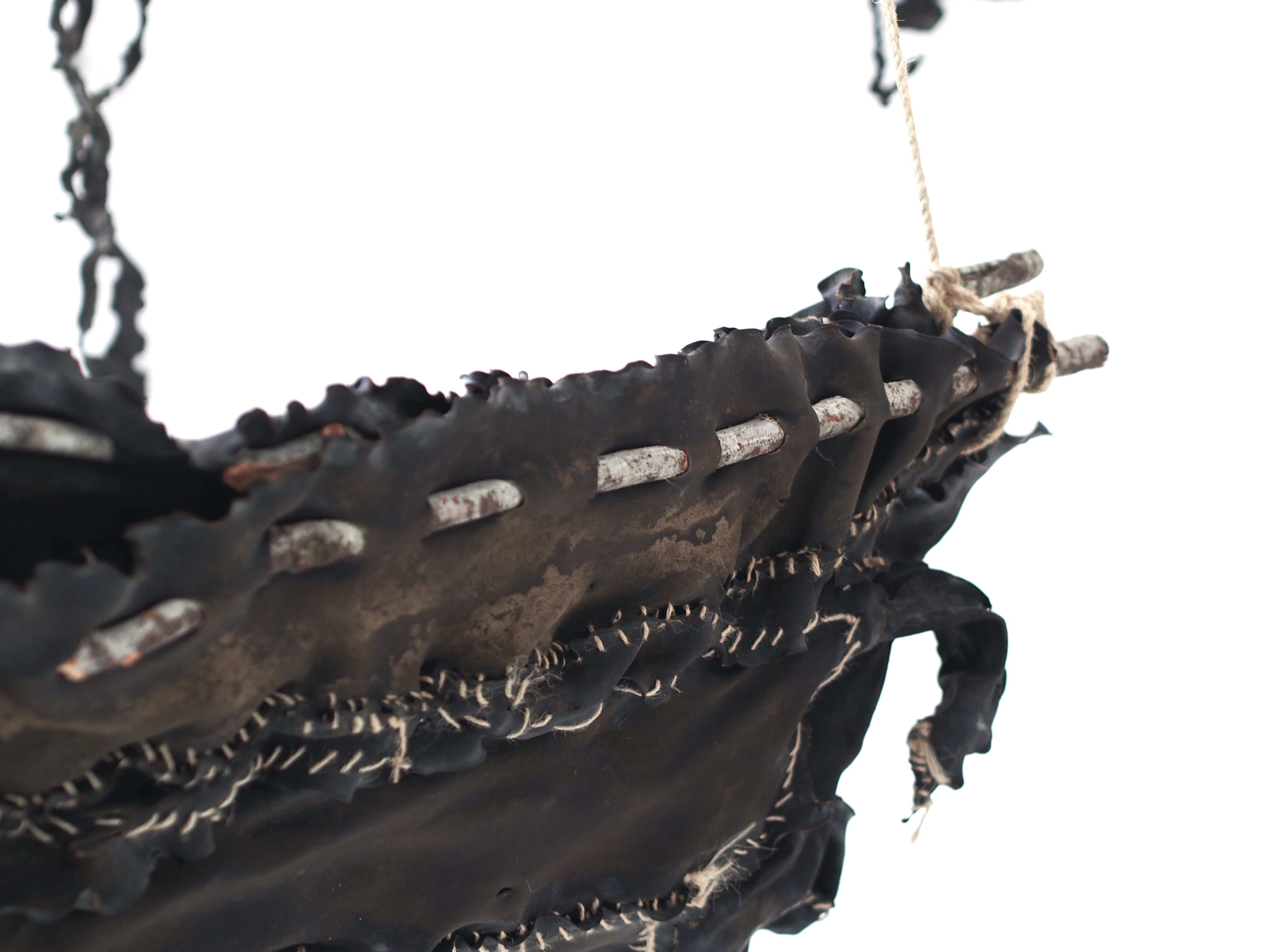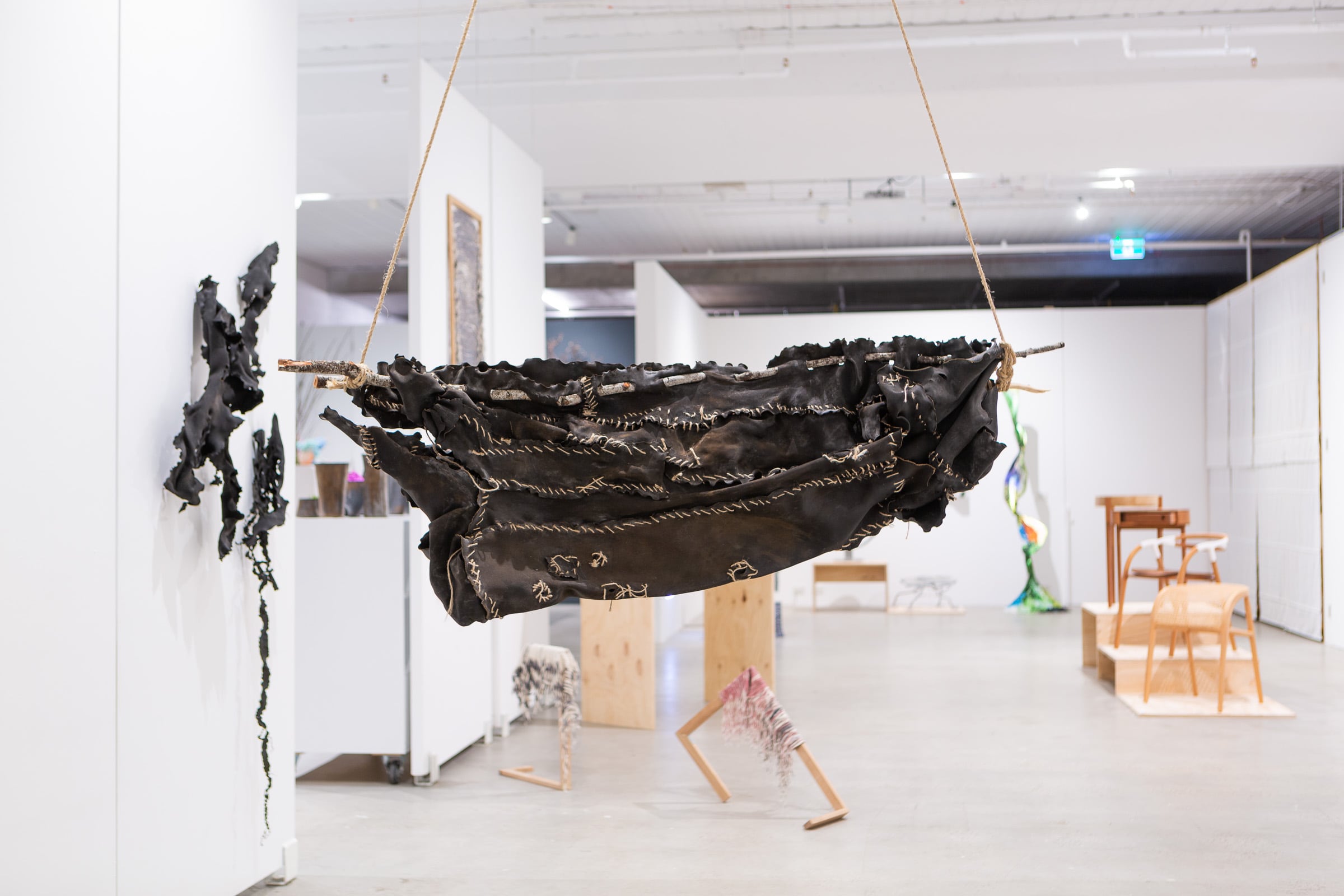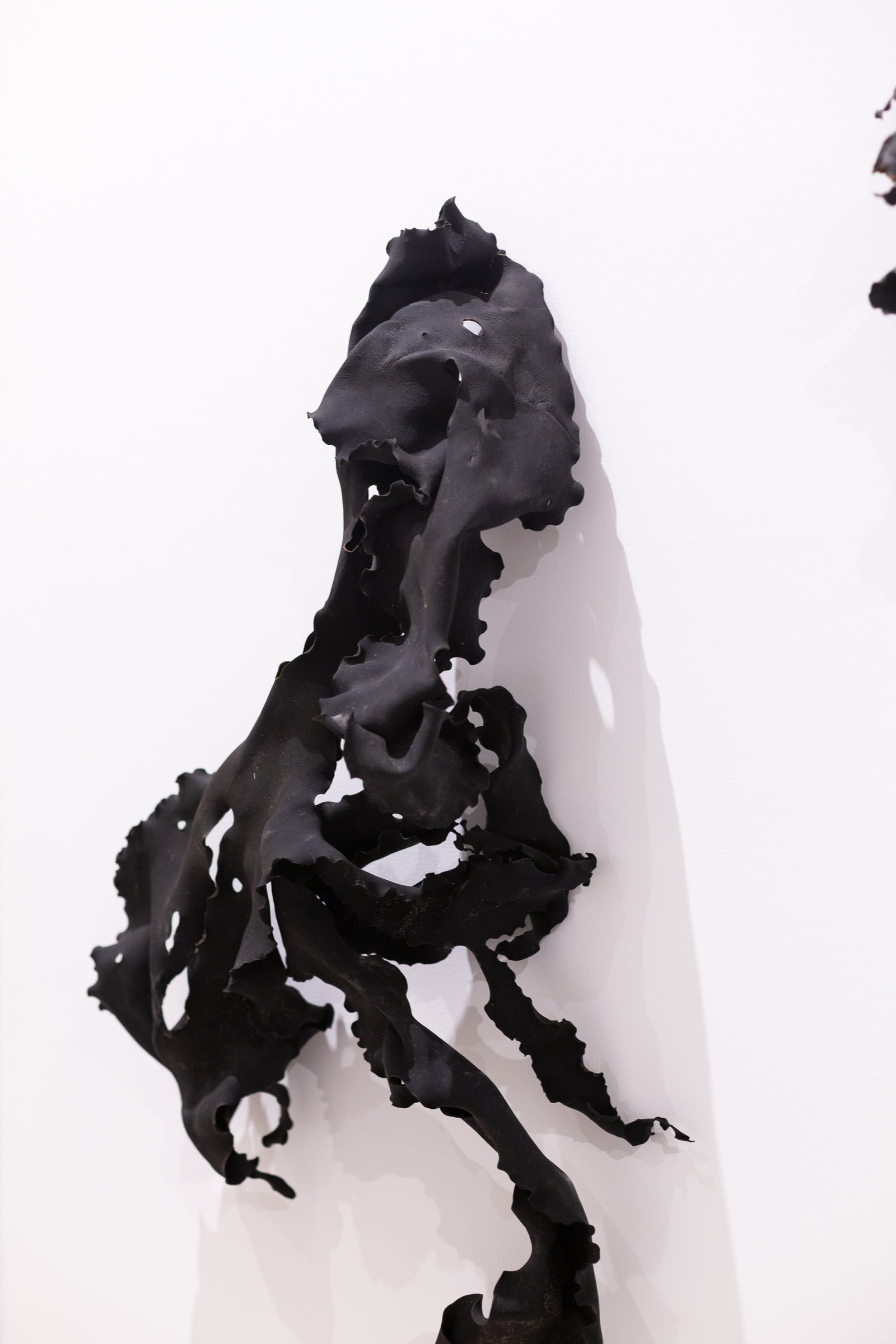



Sea-brown ships glide on heavy warm air, rising to the top floor of SEVENTH Gallery. On second examination the ship-like qualities are replaced by an answer to a more vital need: thirst. The ship plays a cardinal role in the colonial saga and it seems fitting that such heroic propaganda is undermined by Indigenous craft practice. However, when does this characterisation become a burden?
Working across installation, photography and film, Naarm based Trawlwoolway artist Edwina Green’s practice engages with environmental damage, place and politicisation of the blak presence. I'll Carry My Own Water pays homage to the Lutruwita (Tasmanian) tradition of water carrier crafting. Made from dried bull kelp, shaped by wattle tree branches and sewn together by natural fibres, the receptacle hangs from the gallery ceiling, accompanied by smaller water carriers mounted along the wall. Most recently exhibited at Craft Victoria, as part of the Fresh! exhibition, the work toured several Naarm galleries at the beginning of 2020 — from SEVENTH Gallery to BLINDSIDE — in testament to Edwina’s resonance with multiple and various audiences.
The relationship between the water and its materials is intrinsic to Lutruwita culture and identity. As Palawa and Pakana saltwater people of the island, the making of practical tools as well as bodily adornments is emblematic of location and skill. Traditional processes of preparing animal skin, kelp and other materials with smoke and mutton or penguin oil are lengthy and meticulous, adapted differently to the place-story of every material. While water carries are an imperative tool for survival, it’s symbolic of not only Edwina’s identity but also the legacy of her ancestors' real knowledge systems.
It was not an easy process ... with 7am starts and 8pm finishes for four days straight ... We were sewing everyday ... you're exhausted from doing something your ancestors would have been doing.
To pursue crafting today seems an ancestral remembrance of Country, a poignant reminder that Country is not just the land beneath but also the water, the air and everything that they hold. The recommitment to traditional materials and practices among First Nations peoples around the world is increasingly prevalent, especially within contemporary art practices in settler colonies. However, there does seem to be a disconnect between the act of making and how the material sits within a globalised economy of culture. Jennifer Loureide Biddle suggests that the artistic re-practice of making in fact reveals tradition. Through experimentation, the process of doing becomes just as important as the end product. Accordingly, processes such as the collection, drying and sewing of bull kelp are not inherently ‘tradition as salvage’ but, rather, a harnessing of the capacities of tradition.
In un Magazine 12.1: The Unbearable Hotness of Decolonisation, Lauren Burrow and Tristen Harwood wrote about the phenomena of ‘Aboriginal kitsch’, whereby the display of cultural materials and practices is showcased to function ‘like macular degeneration to habituate the sense to colonial presence’ and, in doing so, Aboriginal designs and art ‘are co-opted to legitimise colonisation while syphoning power from Aboriginal cultural forms.’ To be able to gauge in some kind of material way the benefits of ‘culture making or remaking’ presupposes that such art is made within a vacuum, a ‘postcolonial’ void.1 If material worth and the overproduction of ‘crafts’ signify the safety net of consumer driven capitalism, it is easy to see why the re-practicing of traditional crafts is often tasked with the burden of fulfilling a post-colonial fantasy — a fantasy that supposes 'culture making' in the marketplace as an indication of 'overcoming' the legacies of colonisation.
Postcolonialism is defined as the project of reclaiming and rethinking the history and agency of people who have been, and continue to be, subordinated under various forms of imperialism. One of the many arms of imperialism is economic control, an authority over the marketplace that reinforces the cultural beliefs and dogma of the coloniser. Under this logic, equating cultural visibility of First Nations art in the market is a negation of the settler state. However this thinking presumes that physicality has the same worth across cultures; it sees the triumphs of First Nations Peoples in this country as looking and feeling like the triumphs of imperialist colonialism. Crafts are fetishistically framed as ‘decolonising’ acts, a framing that may be contrary to the artists' motivations. Letting the market dictate the worth of such practices also undermines their relational worth to its community.
A parallel with Edwina’s work can be found in the replication of Inuit snow goggles by Inuit artist Mathew Nuqingaq. Matthew rose to some media attention when Prince Charles wore his snow goggles on a visit to Iqaluit during his Canadian tour of 2017, typifying the commonwealth's colonial impulse to contextualise traditional practices as a material prop that compels a narrative of successful colonisation.
Like the art market itself, in this moment Prince Charles and the commonwealth over-valued material worth, while undervaluing traditional practices' capacity to inform cultural knowledge. Indeed, the tools and crafted materials of the Arctic’s First Nations people tell a story of survival and adaptation in extreme conditions. The snow goggles were an extremely useful invention, protecting from snow blindness, ultraviolet and visible light by reducing the amount of light to between two and eight percent. They would also, according to Benjamin Ponthier, ‘become a catalyst for ritualised pattern making and subsequently human consciousness.’ Sharmanic ritualised consumption of a plant from the Ericaceae family, the Ledum Palustre, in combination with drumming to induce trance-like states, meant that the early wearers of these snow goggles would perceive a new birth of visual stimulation. Over time, this completely vital and necessary object would actually change the way people saw, increasing visual acuity and training eyes (and minds) to see in a new and unique way, marking the start of a culture of pattern making across all mediums, from tattoo to embroidery, one whose influence can be traced by following the routes of the Ainu People from what is now known as northern Siberia to northern Japan, taken some 17,000 years ago.2
**
I'll Carry My Own Water’s exigent odour delivers characteristic qualities of its materials’ home environment and literally punctured the clinical aesthetic of each gallery space it occupied. Experiencing this work across various locations became a story within itself. With gallery walls as white as the Arctic snow of the aforementioned snow goggles, I'll Carry My Own Water may be a useful tool in combating the whiteness of these spaces. Figuratively speaking, this parallel signifies the importance of locating cultural objects and their making within their homelands. Experiencing Edwina’s work across various locations became a story within itself. The tokenism, and at times disconnect, that accompanies cultural objects and practice in a whitecube space is a reality — as Neika Lehman writes: ‘what’s easiest for people [is] to consume, to take at the level of metaphor ... and call it a day.’ The very real and alive odour that clung to the walls of each gallery became a sensory embodiment too hard to ignore — every space I walked in smelt, to different extents, like cat piss, which is what happens when sea kelp is dried. Edwina had no control over what odour the kelp would give off and left it up to the humidity and room temperature of each gallery to determine this. It served as a reminder of the journey to the depths of cold water from which this piece was dragged, dried and sewn. A trial of consumer taste - can the offensive reminder of cyclical life be withstood in a society that demarcates itself as cleansed from the natural world outside?
Jenna Rain Warwick is a proud Luritja woman, emerging artist and publishing writer whose work speaks to her desire to champion the creative imagination of First Nations peoples. Jenna is the 2020 un Writer in Residence.
